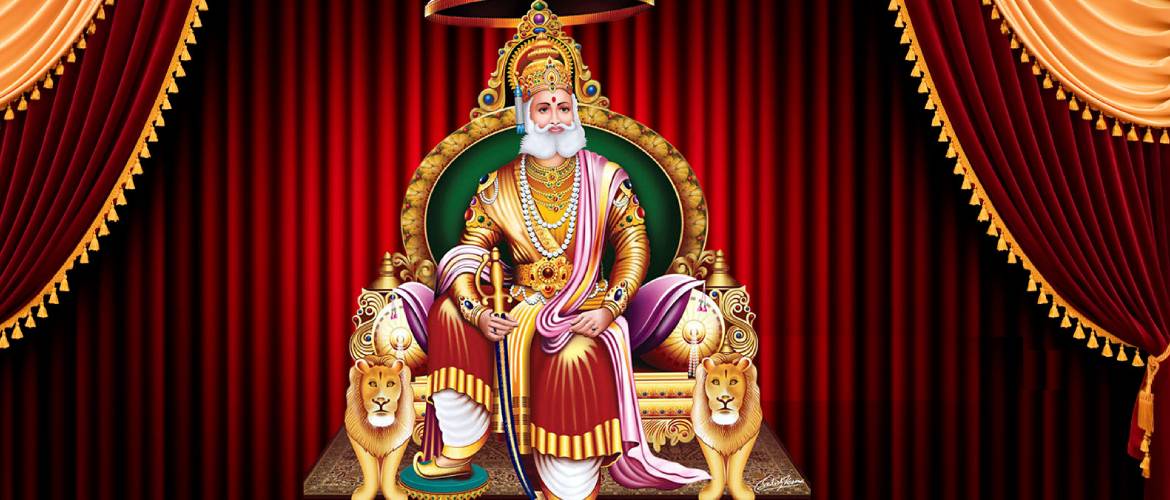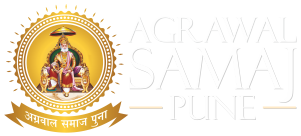
Maharaj Agrasen was born as the eldest son to the Suryavanshi King Ballabh of Pratapnagar, about 5185 years ago, during the Dwapar Yug. He married Princess Madhavi, the daughter of the King Nagaraj. Since he married a Nagavanshi Princess, Agarwals worship Nagaraj and revere snakes.
Agrasen started a severe penance to propitiate Lord Shiva, in the city of Kashi.Pleased with the penance of Agrasen, Lord Shiva appeared and advised him to propitiate Shri Mahalakshmi. Maharaj Agrasen again started meditating on Shri Mahalakshmi, who appeared before him. Goddess Mahalakshmi then blessed Agrasen and suggested that he take up the Vaishya tradition of business for the sake of prosperity of his people. She then asked him to found a new kingdom and promised that she would bless his descendants with prosperity. So he gave up his Kshatriya tradition.
With the blessings of Sri Mahalakhmi, King Agrasen started out with the Queen to travel all over India and select a place for a new kingdom. During his travels, at one place he found a few tiger cubs and wolf cubs playing togethar. To King Agrasen and Queen Madhavi, this was an auspicious indication that the area was Veerabhoomi (land of the brave) and they decided to found their new kingdom at that location named Agroha. Agroha became prosperous as agriculture and trade flourished.
Maharaj Agrasen was moved to see a horse trying to run away from the sacrificial altar during one of his Yagna s. He proclaimed that there shall be no violence against animals and banned killing of animals in his kingdom. He then divided his kingdom among his 18 children and established the 18 Gotra s named after the Gurus of each of his children. He reigned supreme and compassionate till he attained moksha. As the years rolled by, the subjects, known as Aggarwals, of the Kingdom dispersed into various areas far and wide.
Agroha / Agra Republic was established around 51 years before the war of Mahabarat.According to writers of “Bhavishya Puran; Ke Agravansh” “Vanishanukirtnam” and “Uru Charitam” Maharaja Agrasen ruled some 5000 years back over Agroha around the time of Mahabharat.
Agroha was a Republican State consisting of 18 state units. The residents of this states were known asYodhya and Agraya .Some of the writings on the coins that have been excavated from the site of ancient Agroha read as ‘Yodhyanam Bahu Dhanya Kanam’,’Yodhya Ganasya Jaya’, ‘Yodhyanam Jaimantra Shalinam’.
The Agroha republic was renowned for its bravery and prosperity. However over the time it could not stand the foreign invasions of Hunas, Greeks and Yavanas, who invaded the north India disintegrating various kingdoms in Punjab. The disintegrated Agroha led to the migration of the residents of Agroha to other parts of the country viz Rajasthan, Uttar Pradesh, Punjab and Malwa, however they derieved a common name Aggarwals ie. AGROHA-WALE.
HISTORICAL BACKGROUND
Tolmy , a greek writer in his book titled “Example of Geography” has mentioned about a city called “Agara”. This has been equated to “Agrohe” by the geologist Rannal. In the map supplemented in the book of Tolmy “Agara” has been shown at the same place as the present ” AGROHA”
Moshio Prajluski has in his writings identified Agroha as ” Agrodak” or ” Agrod” This statement has been further testified by the writings on coins found from Agroha wherein ‘Agrod’ or ‘Agacha’ state has been written in the Brahm Lipi (script ).
Dr. Satyaketu Vidyalankar has written that Agroha existed some 100 Years before the kushan dynasty.
According to the Punjab Govt. Gazzette ” Agroha” was a very big ancient city. The primary efforts to discover its historical past were made in the year 1888-89, when the Indian Govt. started excavations at the ancient agroha site under archaeologist C.T. Rogers. However the intial excavations were carried out only for 15 Days.
The excavation was restarted in the year 1938-39, though even this could not be carried on for long due to the IInd world war but it provided major historical input towards Agroha’s existence.
In 1978-79 the Archaelogical Department of Haryana Govt. began excavation work under the guidance and supervision of Mr. J.S.Khatri and Mr. Acharya.
It is quite apparent from the excavations that below the mounds existed a big, well planned progressive town
Some of the materials collected from the excavated site :
Coins
Large number of coins have been found at the excavated site. The coins are predominantly of silver & bronze in different shapes and sizes. The Script and signs on the coins depict that they belong to different periods.
The bronze coins have “Agadke,Agach, Janpads” in prakrit language inscribed on them. A coin dated 200 BD called die struck or counter struck has been found besides Roman , Kushana , Yodhaya and Gupta dynasty coins.
Seals:
The seals that have been found at Agroha have been inscribed with words like “Pitradutt” ” Sadhu Vridhasya” “Shamkar Malasya” “Madrsya” etc.
Artifacts:
From the excavation site many statutes made of stone and sand have benn unearthed. Masks, Terracotta Animals and Toys have also been found. Utensils belonging to 2C B.D. in black ,brown and red polish have also been discovered.
Maharaj Agrasen
“In order to live in heaven after death, we shall have to live in heaven before death” avowed Maharaj Agrasen, the king of Agroha, born to king Vallabh of Pratapnagar some 5182 years back. Maharaj Agrasen, was king of great administrative skill. His concepts of kingdom and the duties of the king towards his subjects have evolved him as a centurial man. Equality, Nationalism, Socialism and Non-Violence were the principles which formed the backbone of his kingship.
Maharaj Agrasen established the republican state of Agroha. Agroha consisted of 18 state units. The head of each state unit was given a Gotra . All the residents of that particular state unit were identified by that Gotra . It was maintained by Maharaj Agrasen that a nupital alliance could not take place in the same Gotra .That is a girl of “Goel” Gotra could not marry a “Goel boy”, but could be married in any of the other 17 Gotra . This rule enunciated by Maharaj Agrasen promoted harmony and brotherhood among all the 18 Gotra represented by state units. This facilitated promotion of unity and nationalism among the state units.
| Aren | Bansal | Bhandal | Bindal | Dharan | Garg |
| Goel | Goen | Jindel | Kansal | Kuchhal | Mangal |
| Mittal | Mridkul | Nagal | Singhal | Tayal | Tingal |
Maharaj Agrasen was a doer (a Karmyogi ) who conjured prosperity for all. An adherent of Socialism, he devised a unique rule in order to ensure an egalitarian society. He promulgated that any person coming to Agroha to settle down permanently, shall be given one rupee, one brick, by each resident of Agroha.With the bricks he could build a house for living and with the money so collected he could set up his own business. This way through a small help by each a person could attain a equal status in the society of equals.
He adopted the ideal of Non-Violence during the 18th Yagna , wherein he realised the futility of animal sacrifices. The Yagna was being performed for the establishment of the 18th Gotra . This realisation led him to become one of the strong protagonist of ‘Non-Violence’
“Instead of targeting a crane with an arrow, I wish to see it flying;
Instead of eating away a nightingale, I wish to hear it singing”
He banned all animal sacrifices.
However, his belief in nonviolence did not mean non-resistance to oppression,rather he promoted self defence. According to him self protection and national defence were not the task of only kshatryas – the warrior caste, rather it is the duty of each citizen to protect and safeguard his motherland.
The ideas of Equality, Socialism and non-violence propounded by Maharaj Agrasen 5000 years back form the spirit of the present Constitution of India. But, we Indians have not been able to cultivate these ideals into our lives, they remain simply words in our constitution. It lies upon us now to adopt these ideals in our lives as a tribute to our progenitor.
Agrohadham
LOCATION: AGROHA is located some 20km North-West of the Hissar city in Haryana. This is some 190 km from Delhi (India), when approached via Rohtak-Hissar.
This was some 5000 years back the prosperous and illustrous kingdom of Maharaja Agrasen. The remains of ancient AGROHA city are some 1-1.5 km away from the present AGROHA village. The excavation of the ancient AGROHA city started in the year 1888-89, under C.T.Rogers. It was at that time that people came to know about this great kingdom.
The redevelopment process at Agroha after the excavation was slow. Sh. Bholaram Dalmia of Bhiwani Distt. and Sh. Sanwalram built a Gau Shala in 1914 at Agroha. Then in 1939 Sh. Ramji Das Bojoria from Calcutta had Shiv Mandir and a rest house built. All these activities were more at individualistic level.
It was only in 1976 that a need for a concerted group effort was felt at the convention of All India Aggarwal Representatives. This realisation led to the establishment of AGROHA VIKAS TRUST in 1976, under Sh.Shri Krishna Modi and Sh Rameshwar Das Gupta.Their efforts were supplemented by Late Master Laxmi Narain Gupta who donated 27 acres of land to Agroha Vikas Trust.The development work at Agroha was carried on under the able supervision of Late Sh Tilak Raj Aggarwal.
Since then all the development process at AGROHA is planned and implemented by AGROHA VIKAS TRUST.The developments at Agoha received a major boost from 1985 when Sh. Subhash Goel joined in as the President of Agroha Vikas Trust.He replanned Agroha Dham with special emphasis on the Temple Complex and the Shakti Sarovar. Functionally Agroha Dham has been planned to represent the historical tenets of India- As a centre of learning, philosphy and spirituality, Vridh Ashram (Old Age Home), Health Centre, Research Centre.
The total area under the trust for the development of Agroha Dham is 27 acres. The developments have taken place in the form of a Temple complex dedicated to goddess Mahalaxmi and Saraswati , this also hosts the memorial temple of Maharaj Agrasen. The beauty of the place is exemplified by the Shakti Sarovar and well maintained lawns.
Opposite the Trust compound is the Agrasen Medical College and Research Centre.The medical college is one of the most prestigious education centre for medical studies.It is gearing up to become one of the biggest medical research centre under the supervision of Sh. O. P. Jindal. Less than a Kilometre away from the trust compound is the ancient Temple of Sheela Mata which has become a major tourist attraction.
Some more developments are under way at Agroha viz: Maharaj Agrasen Agroha House Building Coop Society, Hissar: which is spread over an area of 25 acres covering 300 plots .Besides this there is a Grain Market under development. This is a controlled area to be developed in a planned manner.
